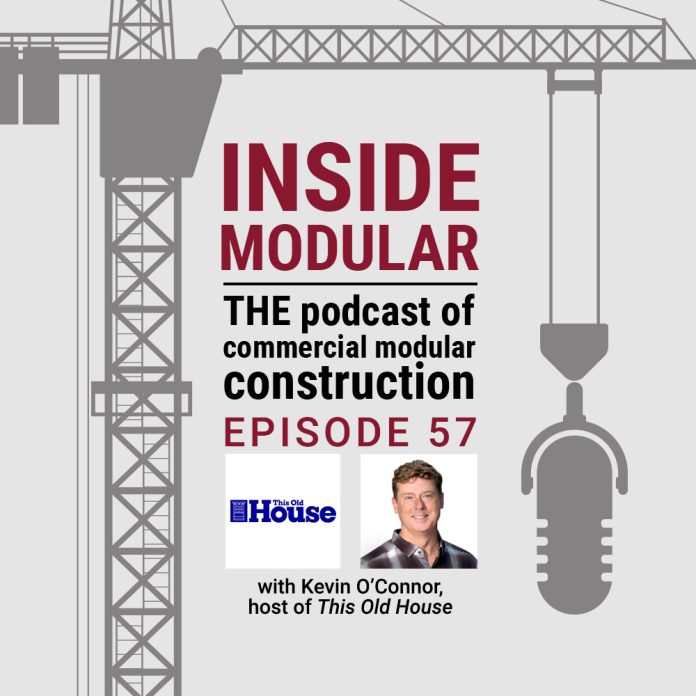Kevin O’Connor, the host of the Emmy-winning home-improvement series This Old House, discusses where his life in construction, and the future of the industry
This Old House has utilised modular construction techniques for projects affected by Superstorm Sandy. Kevin believes that the construction industry’s resistance to embracing new technology can be attributed to the small size of companies, which limits innovation and access to resources.
Kevin spoke about these topics on the Inside Modular Podcast.
Tell us about yourself. What’s your background, and how did you get to become the host of This Old House?
My route to hosting the show is quite unconventional. My previous career was in finance. I was a commercial banker, which I started after business school. Prior to that was actually working in the legislature here in Massachusetts and the governor’s office. I was always interested in construction.
My father is an engineer. So, we were on his job sites growing up, making money for summer work, college breaks and stuff like that. I never went down that path, but I always had a passion for it.
When I first got married to my wife, Kathleen, we immediately went out and bought a two-family fixer-upper because it was all we could afford. We both were interested in kind of working with our hands and working on it.
Having grown up as a fan of This Old House, as soon as we sort of got into this project and over our heads, we ended up, for some reason writing This Old Houses’ magazine. A letter looking for some information led to them reading it and deciding to send a camera crew out and Tom Silva to our house.
We filmed a little segment for what was then a brand new show for us called Ask This Old House. Out of the blue, three weeks later, I got a call, and they asked me if I wanted to be the host of the shows.
So it was the right place, right time. No desire to be on TV. I’d never done any performing or anything like that, but was such a fan of the show and the good folks who are on it that I decided, yeah, why not?
Can you tell us about some of the ways you use offsite construction for the show?
We went down to New Jersey after superstorm Sandy, and we worked on three homes that were damaged. One was a cottage; it was more of a conventional renovation. Another one was sort of a home from the 80s where we lifted an entire story and were able to put helical piles underneath it. The third house was too far gone, and it had to come down.
So, our contractors, Early Homes, given both the labour shortage but also an acute shortage caused by all of the houses that were damaged from superstorm Sandy, went and they ended up having houses built off-site and craned into place so that they were put together in about a week’s time. That’s how we use modular construction to accelerate the building process but also to get us resources that we couldn’t otherwise get.
A home that was manufactured, I believe, in Pennsylvania, where the resources were not interrupted in terms of manpower as well as materials. And you couldn’t find materials or manpower in the New Jersey area because 10s of 1000s of people were doing the exact same thing at the exact same time.
So that’s just one example. We’ve done it for custom high-end homes. We’ve done it for parts and components for renovations and restorations and such. That’s pretty much across the board.
Why doesn’t the greater construction industry seem willing to embrace new construction technology?
I think it’s complicated. I certainly don’t have all the answers. I thought about it a lot. In my mind, in the residential construction business that we’re familiar with, I would say that the number one limiting factor is the size of these companies.
They tend to be very small and very geographically focused. There are a couple of stats that I just keep in my mind to help paint this picture. There are roughly 600,000 construction companies in the country, and a full quarter of them have one individual.
It’s a sole proprietor, single fabricator type of construction company obviously using subs, but think about that. If you bump that number up to 20 or fewer employees, which is kind of the definition of a small company, that percentage exceeds 90%.
Across the industry, they’re very small companies focused on a very limited geographic focus, and I think size limits your ability to innovate. I think size limits your ability to access resources, whether it’s off-site construction, the materials you need, or the latest construction technology. I think it’s an inhibitor to recruiting. So again, it is complicated.
I think there’s more than just one thing, but I think the small size of these companies is what constrains their productivity and their ability to innovate. If I could go a little further, productivity in the construction industry as a whole is generally been flat since the end of World War Two on a year-over-year basis.
That’s pretty damning to the industry when you think about things like agriculture or manufacturing, where their productivity has increased over 1500% by comparison. It paints a very blunt picture.
If you were to take the construction industry and then start to bifurcate. What you see is that the smaller construction companies are stagnated when it comes to productivity. By comparison, the larger components of the construction industry and the industrial side, some of the larger manufacturing, end up getting a 20-40% increase in productivity in construction compared to the smaller companies. I think that sort of reinforces my thinking that size is an inhibitor to these things.
To listen to the full episode and to view more content, click here.

















